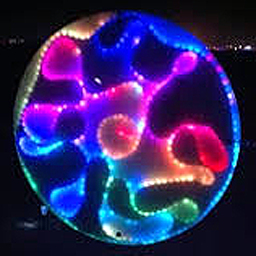#ifdef __AVR__
void setup() {}
void loop() {}
#else
#define LED_PIN 3
#define BRIGHTNESS 96
#define LED_TYPE WS2811
#define COLOR_ORDER GRB
const uint8_t kMatrixWidth = 16;
const uint8_t kMatrixHeight = 16;
const bool kMatrixSerpentineLayout = true;
#define NUM_LEDS (kMatrixWidth * kMatrixHeight)
#define MAX_DIMENSION ((kMatrixWidth>kMatrixHeight) ? kMatrixWidth : kMatrixHeight)
CRGB leds[kMatrixWidth * kMatrixHeight];
static uint16_t x;
static uint16_t y;
static uint16_t z;
uint16_t speed = 20;
uint16_t scale = 30;
uint8_t noise[MAX_DIMENSION][MAX_DIMENSION];
uint8_t colorLoop = 1;
void SetupRandomPalette();
void SetupPurpleAndGreenPalette();
void SetupBlackAndWhiteStripedPalette();
void SetupRandomPalette();
void ChangePaletteAndSettingsPeriodically();
void mapNoiseToLEDsUsingPalette();
uint16_t XY( uint8_t x, uint8_t y);
void setup() {
delay(3000);
}
void fillnoise8() {
uint8_t dataSmoothing = 0;
if( speed < 50) {
dataSmoothing = 200 - (speed * 4);
}
for(int i = 0; i < MAX_DIMENSION; i++) {
int ioffset = scale * i;
for(int j = 0; j < MAX_DIMENSION; j++) {
int joffset = scale * j;
uint8_t data =
inoise8(x + ioffset,y + joffset,z);
if( dataSmoothing ) {
uint8_t olddata = noise[i][j];
uint8_t newdata =
scale8( olddata, dataSmoothing) +
scale8( data, 256 - dataSmoothing);
data = newdata;
}
noise[i][j] = data;
}
}
z += speed;
x += speed / 8;
y -= speed / 16;
}
void mapNoiseToLEDsUsingPalette()
{
static uint8_t ihue=0;
for(int i = 0; i < kMatrixWidth; i++) {
for(int j = 0; j < kMatrixHeight; j++) {
uint8_t index = noise[j][i];
uint8_t bri = noise[i][j];
if( colorLoop) {
index += ihue;
}
if( bri > 127 ) {
bri = 255;
} else {
}
leds[XY(i,j)] = color;
}
}
ihue+=1;
}
void loop() {
ChangePaletteAndSettingsPeriodically();
fillnoise8();
mapNoiseToLEDsUsingPalette();
}
#define HOLD_PALETTES_X_TIMES_AS_LONG 1
void ChangePaletteAndSettingsPeriodically()
{
uint8_t secondHand = ((millis() / 1000) / HOLD_PALETTES_X_TIMES_AS_LONG) % 60;
static uint8_t lastSecond = 99;
if( lastSecond != secondHand) {
lastSecond = secondHand;
if( secondHand == 0) { currentPalette =
RainbowColors_p; speed = 20; scale = 30; colorLoop = 1; }
if( secondHand == 5) { SetupPurpleAndGreenPalette(); speed = 10; scale = 50; colorLoop = 1; }
if( secondHand == 10) { SetupBlackAndWhiteStripedPalette(); speed = 20; scale = 30; colorLoop = 1; }
if( secondHand == 15) { currentPalette =
ForestColors_p; speed = 8; scale =120; colorLoop = 0; }
if( secondHand == 20) { currentPalette =
CloudColors_p; speed = 4; scale = 30; colorLoop = 0; }
if( secondHand == 25) { currentPalette =
LavaColors_p; speed = 8; scale = 50; colorLoop = 0; }
if( secondHand == 30) { currentPalette =
OceanColors_p; speed = 20; scale = 90; colorLoop = 0; }
if( secondHand == 35) { currentPalette =
PartyColors_p; speed = 20; scale = 30; colorLoop = 1; }
if( secondHand == 40) { SetupRandomPalette(); speed = 20; scale = 20; colorLoop = 1; }
if( secondHand == 45) { SetupRandomPalette(); speed = 50; scale = 50; colorLoop = 1; }
if( secondHand == 50) { SetupRandomPalette(); speed = 90; scale = 90; colorLoop = 1; }
}
}
void SetupRandomPalette()
{
}
void SetupBlackAndWhiteStripedPalette()
{
}
void SetupPurpleAndGreenPalette()
{
green, green, black, black,
purple, purple, black, black,
green, green, black, black,
purple, purple, black, black );
}
uint16_t XY( uint8_t x, uint8_t y)
{
uint16_t i;
if( kMatrixSerpentineLayout == false) {
i = (y * kMatrixWidth) + x;
}
if( kMatrixSerpentineLayout == true) {
if( y & 0x01) {
uint8_t reverseX = (kMatrixWidth - 1) - x;
i = (y * kMatrixWidth) + reverseX;
} else {
i = (y * kMatrixWidth) + x;
}
}
return i;
}
#endif
CFastLED FastLED
Global LED strip management instance.
central include file for FastLED, defines the CFastLED class/object
void setBrightness(uint8_t scale)
Set the global brightness scaling.
void show(uint8_t scale)
Update all our controllers with the current led colors, using the passed in brightness.
static CLEDController & addLeds(CLEDController *pLed, struct CRGB *data, int nLedsOrOffset, int nLedsIfOffset=0)
Add a CLEDController instance to the world.
RGB color palette with 16 discrete values.
void fill_solid(struct CRGB *targetArray, int numToFill, const struct CRGB &color)
Fill a range of LEDs with a solid color.
LIB8STATIC uint8_t dim8_raw(uint8_t x)
Adjust a scaling value for dimming.
LIB8STATIC_ALWAYS_INLINE uint8_t qadd8(uint8_t i, uint8_t j)
Add one byte to another, saturating at 0xFF.
LIB8STATIC_ALWAYS_INLINE uint8_t qsub8(uint8_t i, uint8_t j)
Subtract one byte from another, saturating at 0x00.
uint8_t inoise8(uint16_t x, uint16_t y, uint16_t z)
8-Bit, fixed point implementation of Perlin's noise.
CRGB ColorFromPalette(const CRGBPalette16 &pal, uint8_t index, uint8_t brightness, TBlendType blendType)
Get a color from a palette.
@ HUE_PURPLE
Purple (270°)
const TProgmemRGBPalette16 RainbowStripeColors_p
HSV Rainbow colors with alternatating stripes of black.
const TProgmemRGBPalette16 OceanColors_p
Ocean colors, blues and whites.
const TProgmemRGBPalette16 CloudColors_p
Cloudy color palette.
const TProgmemRGBPalette16 ForestColors_p
Forest colors, greens.
const TProgmemRGBPalette16 LavaColors_p
Lava color palette.
const TProgmemRGBPalette16 PartyColors_p
HSV color ramp: blue, purple, pink, red, orange, yellow (and back).
const TProgmemRGBPalette16 RainbowColors_p
HSV Rainbow.
LIB8STATIC uint16_t random16()
Generate a 16-bit random number.
LIB8STATIC uint8_t random8()
Generate an 8-bit random number.
LIB8STATIC_ALWAYS_INLINE uint8_t scale8(uint8_t i, fract8 scale)
Scale one byte by a second one, which is treated as the numerator of a fraction whose denominator is ...
Representation of an HSV pixel (hue, saturation, value (aka brightness)).
Representation of an RGB pixel (Red, Green, Blue)

